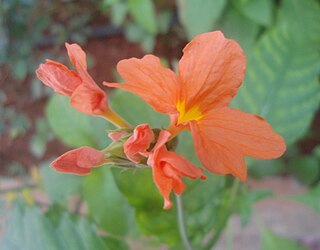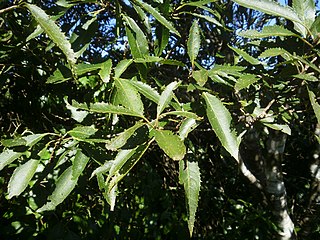
Justicia brandegeeana, the Mexican shrimp plant, shrimp plant or false hop, is an evergreen shrub in the genus Justicia of the acanthus family Acanthaceae, native to Mexico, and also naturalized in Florida.

Hibiscus syriacus is a species of flowering plant in the mallow family, Malvaceae. It is native to Korea, and south-central and southeast China, but widely introduced elsewhere, including much of Asia. It was given the epithet syriacus because it had been collected from gardens in Syria. Common names include the rose of Sharon,, Syrian ketmia, shrub althea, and rose mallow. It is the national flower of South Korea and is mentioned in the South Korean national anthem.

Hydrangea quercifolia, commonly known as oakleaf hydrangea or oak-leaved hydrangea, is a species of flowering plant in the family Hydrangeaceae. It is native to the southeastern United States, in woodland habitats from North Carolina west to Tennessee, and south to Florida and Louisiana. A deciduous shrub with white showy flower heads, it is grown as a garden plant, with numerous cultivars available commercially.

Lavandula angustifolia, formerly L. officinalis, is a flowering plant in the family Lamiaceae, native to the Mediterranean. Its common names include lavender, true lavender and English lavender ; also garden lavender, common lavender and narrow-leaved lavender.

Juniperus squamata, the flaky juniper, or Himalayan juniper is a species of coniferous shrub in the cypress family Cupressaceae, native to the Himalayas and China.

Jasminum nudiflorum, the winter jasmine, is a slender, deciduous shrub native to China. The flower's blossoming peaks right after winter, which is why it is also named Yingchun (迎春) in Chinese, which means "the flower that welcomes Spring". It is widely cultivated as an ornamental and is reportedly naturalized in France and in scattered locations in the United States.

Pachystachys lutea, known as the golden shrimp plant or lollipop plant, is a tropical, soft-stemmed evergreen shrub between 0.5 and 2.5 meters tall, native to Peru. The zygomorphic, long-throated, short-lived white flowers emerge sequentially from overlapping bright yellow bracts on racemes that are produced throughout the warm months.

Justicia floribunda is a species of flowering plant in the acanthus family Acanthaceae, native to Brazil.

Kalmia angustifolia is a flowering shrub in the family Ericaceae, commonly known as sheep laurel. It is distributed in eastern North America from Ontario and Quebec south to Virginia. It grows commonly in dry habitats in the boreal forest, and may become dominant over large areas after fire or logging. Like many plant species of infertile habitats it has evergreen leaves and mycorrhizal associations with fungi. It is also found in drier area of peat bogs.

Plumbago auriculata, the cape leadwort, blue plumbago or Cape plumbago, is a species of flowering plant in the family Plumbaginaceae, native to South Africa.

Euphorbia horrida, the African milk barrel, is a species of flowering plant in the family Euphorbiaceae, native to South Africa. It is a cactus-like shrub showing remarkable similarities to the true cacti of the New World, and thus an example of convergent evolution. Growing to 1.5 m, it has blue-green, heavily ridged spiny stems carrying solitary green flowers in summer. In temperate regions it must be grown in heated conditions under glass.

Crossandra infundibuliformis, the firecracker flower, is a species of flowering plant in the family Acanthaceae, native to southern India and Sri Lanka. It is most often found in south Indian region Malenadu and Kerala.

Hypoestes phyllostachya, the polka dot plant, is a species of flowering plant in the family Acanthaceae, native to South Africa, Madagascar, and south east Asia. The spots often merge into larger areas of colour.

Hoheria sexstylosa, the long-leaved lacebark or ribbonwood, is a species of flowering plant in the family Malvaceae, endemic to New Zealand. It is an evergreen tree or shrub growing to 8 m (26 ft) tall by 6 m (20 ft) broad with glossy green leaves, and white flowers in summer and autumn. The Latin specific epithet sexstylosa means "six styles".

Daphne tangutica, syn. Daphne retusa, is a species of flowering plant in the family Thymelaeaceae, native to Tibet, China, and possibly Taiwan. It is an evergreen shrub growing to 1 m tall and wide, with leathery leaves and clusters of fragrant white and pink flowers in spring. The flowers are often followed by red berries. It grows in forests.

Allium carinatum, the keeled garlic or witch's garlic, is a bulbous perennial flowering plant in the family Amaryllidaceae. It is widespread across central and southern Europe, with some populations in Asiatic Turkey. It is cultivated in many places as an ornamental and also for its potently aromatic bulbs used as a food flavoring.

Strobilanthes dyeriana, the Persian shield or royal purple plant, is a species of flowering plant in the acanthus family Acanthaceae, native to Myanmar.

Hypericum kouytchense, the large-flowered St John’s wort, is a species of flowering plant in the family Hypericaceae, native to Western China. Growing up to 3 ft (0.91 m) tall and 5 ft (1.5 m) wide, it is a semi-evergreen rounded shrub with blue-green leaves and large yellow flowers with prominent stamens, appearing in midsummer. Flowers are followed by red seed capsules in autumn. Where conditions are favourable it can retain its leaves all year.

Clematis heracleifolia, the tube clematis, is a species of flowering plant in the buttercup family Ranunculaceae, native to central and northern China. Unlike most other members of the genus Clematis, it has a scrambling rather than a climbing habit.

Mackaya is a genus of flowering plants in the family Acanthaceae, disjunctly distributed in Brazil, South Africa, and the eastern Himalayas, Southeast Asia and China. It is sister to Asystasia.




















